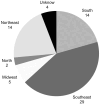Clinical and epidemiological profile of congenital hyperinsulinism in Brazil
- PMID: 40270719
- PMCID: PMC12014427
- DOI: 10.3389/fendo.2025.1547855
Clinical and epidemiological profile of congenital hyperinsulinism in Brazil
Abstract
Introduction: Congenital hyperinsulinism is the most common cause of persistent hypoglycemia in children, often leading to severe neurological complications. Objective: This study aimed to describe the clinical and epidemiological profile of CHI in Brazil.
Methods: A cross- sectional study was conducted with caregivers of CHI patients affiliated with the Associação do Hiperinsulinismo Congênito do Brasil. Data were collected via a structured questionnaire adapted from the HI Global Registry, covering clinical presentation, diagnostic pathways, genetic findings, and treatment strategies.
Results: Caregivers of 68 patients participated. Symptoms appeared before six months of age in 60% of cases, but 35.5% initially received incorrect diagnoses. Genetic testing was performed in 43 patients, but pathogenic variants were identified in only 7 cases, while the majority (31) was not aware of their results. Diazoxide was the most used medication, though 13% required pancreatectomy. Developmental delays were reported in 44% of cases.
Conclusions: Delayed diagnosis and limited access to genetic testing and specialized treatments remain significant barriers in Brazil. This study underscores the need for improved awareness, early recognition strategies, and expanded access to genetic and therapeutic resources to optimize patient outcomes.
Keywords: children; congenital hyperinsulinsm; hyperinsulinism hypoglycemia; hypoglycemia; newborn.
Copyright © 2025 Liberatore Junior, Marques, Dos Santos and Luciano.
Conflict of interest statement
The authors declare that the research was conducted in the absence of any commercial or financial relationships that could be construed as a potential conflict of interest.
Figures
References
-
- De Franco E, Flanagan SE, Yau D, Houghton JA, Laver TW, Ellard S, et al. . Update of variants identified in the pancreatic β-cell KATP channel genes KCNJ11 and ABCC8 in individuals with congenital hyperinsulinism and diabetes. Hum Mutat. (2020) 41:884–905. doi: 10.1002/humu.23987 - DOI - PMC - PubMed
MeSH terms
LinkOut - more resources
Full Text Sources




